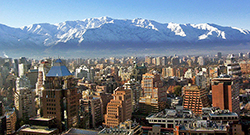PhD defense: Chemical characterization of submicron aerosol particles with aerosol mass spectrometers

In her PhD thesis she found out that the chemistry and sources of aerosol particles were different in rural, urban and background areas.
Atmospheric aerosol particles, also called particulate matter (PM), correspond to a mixture of liquid and solid phase chemical compounds suspended in the air. They are largely emitted by natural sources and human activities. In urban environments the PM has been responsible for degrading the air quality and therefore the identification of its sources is the most effective way of mitigation air pollution in urban areas. The PM plays an important role in human health being responsible for causing e.g. respiratory and cardiovascular diseases. In addition, it interacts with the solar radiation changing the amount of energy that reaches the surface of the planet and therefore affects the global climate. PM is also important in the process of cloud formation and precipitation. For these reasons all information concerning the composition, size, solubility in water and evolution in the atmosphere of PM is important in order to fully understand the complex processes where the PM is involved.
Mass Spectrometers revealed the sources of particles
This research study brings new insights into the composition of atmospheric aerosol particles. For that, the technique of mass spectrometry was deployed and the composition and sources of PM (particles smaller than 1 µm in diameter, PM1) were investigated with high time-resolution (2-5 minutes) in three different locations, Helsinki (Finland), San Pietro Capofiume (Italy), and Santiago de Chile (Chile). Those places were chosen because they represent different atmospheric environments, urban background, rural and urban, respectively. The high time-resolution instruments used in this research allowed to study fast changes in the chemical composition of the PM1 throughout the day, which was very helpful in the identification of local sources, such as industry and wood burning for domestic heating.
The highest levels of PM1 were observed in Santiago de Chile where the recommended levels by the World Health Organization (WHO) were very often exceeded. In Helsinki, the PM levels were mostly below the recommended WHO levels. In addition, the compounds organic and sulfate were verified to be partly originated in the central and eastern European countries and transported to Helsinki by air masses. The low levels of sulfate in the PM1 confirmed the low sulfur content used by the local heating stations. Also burning of wood for domestic heating and traffic were identified as important contributors to the PM in this location. Moreover, the PM1 properties, particle density, size, solubility in water and aging investigated in this research study might be useful in global climate models where changes in the climate can be investigated in more detail.
In addition to the compounds identified in this study (organics, sulfate, nitrate, ammonium, chloride and, black carbon) also a technique was developed in the laboratory in order to evaluate the possibility of determining the levels of trace elements in real time. The technique successfully identified 13 different metals: Sodium, Aluminum, Calcium, Vanadium, Chromium, Iron, Manganese, Nickel, Copper, Zinc, Rubidium, Strontium and Barium. The determination of these elements will be useful in identification of new sources of PM1 in the future studies. Also, in controlled engine emission experiments the detection of trace elements in real time is useful in order to evaluate the engine performance.
Samara Carbone was born in 1982 in Sao Paolo, Brazil. She has a M.Sc. degree in Meteorology from the University of Santa Maria. She will defend her PhD thesis "Chemical characterization of submicron aerosol particles with aerosol mass spectrometers" on 5.4.2014 at 13 o'clock in the University of Helsinki, the Faculty of Science. The defense will be held in Physicum auditorium E204, Gustaf Hällströminkatu 2, Helsinki. Opponent will be Associate Professor Joakim H. Pagels from the Lund University and Custos Professor Veli-Matti Kerminen.
PhD thesis will be published in Finnish Meteorological Institute Contributions.
More information:
Researcher Samara Carbone, tel. 050 406 4737, Samara.Carbone@fmi.fi
